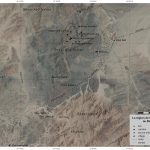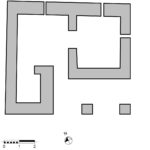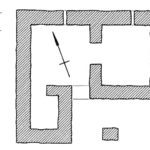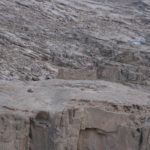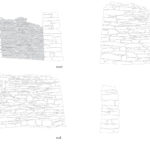BIʾR NAQĀṬ
| Arabic | بئر قطّار | بئر نقاط |
| English | Bir Naqat | Qattâr | Qaṭṭâr | Wādi Ḳaṭṭār | Biʾr Qaṭṭār |
| DEChriM ID | 16 |
| Trismegistos GeoID | 60548 |
| Pleiades ID | - | PAThs ID | - |
| Ancient name | - |
| Modern name | Biʾr Naqāṭ |
| Latitude | 27.050136 |
| Longitude | 33.282583 |
| Date from | 330 |
| Date to | 700 |
| Typology | Monastic settlement |
| Dating criteria | Dedicatory stela; analysis (in 2012, by Zulema Barahona Mendieta) of the ceramic fragments found around the church; literary sources. |
| Description | Biʾr Naqāṭ is located in the eponymous valley, a tributary of the Wādī Qaṭṭār, in the heart of Ǧabal Qaṭṭār, one of the mountains of the Ǧabal Šāyb al-Banāt massif in the Eastern Desert. The site is situated near the ancient road connecting Abū Šaʿār with Kainopolis/Qinā. It is one of only two sites in the Eastern Desert which have known fourth century Christian remains, the other being Mons Porphyrites in Ǧabal Abū Duḫān, and is the only archaeologically attested early monastic site in the “Interior Desert” (Ghica 2016: 244; Ghica 2019: 128). The site contains a well-preserved church which, thanks to an in-situ stela, is known to have been sponsored by Flavius Julius, governor of the Thebaid, and was constructed between 325 and 339 (Wilkinson 1832: 49; Tregenza 1949: 146; Murray 1951: 113; Meredith 1953: 132; Bernand 1977: 68-70; Łajtar and Wipszycka 1994: 71-72). While it was not originally constructed as a monastic church, the site became home to a monastic community after it fell out of official use, probably correlating with the fourth century abandonment of Dayr Qaṭṭār, a Roman fort located 6.9km NW (Sidebotham, Zitterkopf and Riley 1991: 583a; Ghica 2016: 244). The monastic occupants erected a dozen dry stone buildings in a typological line that we find later in the hermitages of the Wādī ʿAraba and the laura of Abū Daraǧ (Ghica 2019: 128). The clear differences in construction techniques between the church and the cells/hermitages support the asynchronous relationship between the phases of use. The presence of hermits is additionally attested to by literary testimonies, the first of whom is understood to have inhabited the area between 372 and 376 (Murray 1951: 110; Malingrey & Leclerq 1988: 338-339). Analysis of the ceramic assemblages found around the church indicates dates ranging from the fifth/sixth to seventh centuries (Ghica 2016: 245). However, presence of fourth century ceramic cannot be excluded, considering the date of the church’s construction (Ghica 2016: 246). |
| Archaeological research | The site was first noted by Wilkinson in 1823, who was the first to document the dedicatory inscription. The ceramic assemblages from area surrounding the church were studied in January 2012 by Zulema Barahona Mendieta, as part of a research project led by Victor Ghica at the Institut français d’archéologie orientale. |
• Bernand, A. 1977. Pan du désert, 68-70. Leiden: Brill.
• Ciglenečki, J. 2017. “Wadi Naqqat, The Laura of”, In Claremont Coptic Encyclopedia, edited by Karen Torjesen and Gawdat Gabra, Claremont: Claremont Graduate University (https://ccdl.claremont.edu/digital/api/collection/cce/id/2144/page/0/inline/cce_2144_0)
• Ghica, V. 2016. “Vecteurs de la christianisation de l’Égypte au IVe siècle à la lumière des sources archéologiques.” In Acta XVI Congressus Internationalis Archaeologiae Christianae, Romae 22-28.9.2013, edited by Olof Brandt and Gabriele Castiglia, 244-245, fig. 7 and fig. 9h. Città del Vaticano: Pontificio Istituto di Archeologia Cristiana.
• Ghica, V. 2019. “L’archéologie du monachisme égyptien au IVe siècle: État de la question.” In Nag Hammadi à 70 ans, qu’avons-nous appris? Nag Hammadi at 70: What Have We Learned? Colloque international, Québec, Université Laval, 29-31 mai 2015, edited by Eric Crégheur, Louis Painchaud and Tuomas Rasimus, 128. Leuven-Paris-Bristol: Peeters.
• Łajtar, A and E. Wipszycka. 1994. “Deux katholikai ekklêsiai dans le Mons Porphyrites.” Juristic Journal of Papyrology 24: 71-72.
• Meredith, D. 1953. “Eastern Desert of Egypt. Notes on Inscriptions.” Chronique d’Égypte 28: 132.
• Murray, G. W. 1951. “The Christian Settlement at Qattâr.” Bulletin de la Société royale de géographie d’Égypte 24: 110.
• Sidebotham, S. E, R. E. Zitterkopf and J. A. Riley. 1991. “Survey of the ’Abu Sha’ar-Nile Road.” American Journal of Archaeology 95: 583a.
• Tregenza, L. A. 1949. “Notes on Inscriptions and Graffiti at Mons Claudianus and Mons Porphyrites and on the ‘Flavius’ Stone in Wadi Qattar, Collected During a Visit to the S.E. Desert in the Summer of 1949.” Bulletin of the Faculty of Arts, Fuad I University 11, 2: 146.
• Wilkinson, J. 1832. “Notes on a Part of the Eastern Desert of Upper Egypt.” Journal of the Royal Geographical Society of London 2: 49.


 Json data
Json data